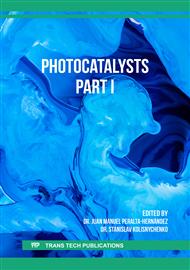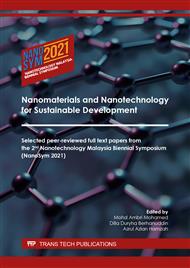[1]
T. Kamegawa, K. Irikawa, and H. Yamashita, Multifunctional surface designed by nanocomposite coating of polytetrafluoroethylene and TiO2 photocatalyst: Self-cleaning and superhydrophobicity,, Sci. Rep., vol. 7, no. 1, pp.1-2, 2017,.
DOI: 10.1038/s41598-017-14058-9
Google Scholar
[2]
M.Q. Khan et al., Self-cleaning properties of electrospun PVA/TiO2 and PVA/ZnO nanofibers composites,, Nanomaterials, vol. 8, no. 9, 2018,.
DOI: 10.3390/nano8090644
Google Scholar
[3]
A. Syafiq, A. K. Pandey, V. Balakrishnan, and N. A. Rahim, Study on self-cleaning performance and hydrophobicity of TiO2/silane coatings,, Pigment Resin Technol., vol. 2016, no. August, 2018,.
DOI: 10.1108/prt-02-2018-0010
Google Scholar
[4]
C. Peng, Z. Chen, and M. K. Tiwari, All-organic superhydrophobic coatings with mechanochemical robustness and liquid impalement resistance,, Nat. Mater., vol. 17, no. 4, p.355–360, 2018,.
DOI: 10.1038/s41563-018-0044-2
Google Scholar
[5]
J. Zhou, Z. Tan, Z. Liu, M. Jing, W. Liu, and W. Fu, Preparation of transparent fluorocarbon/ TiO2-SiO2 composite coating with improved self-cleaning performance and anti-aging property,, Appl. Surf. Sci., vol. 396, p.161–168, 2017,.
DOI: 10.1016/j.apsusc.2016.11.014
Google Scholar
[6]
L. Zou, A.D. Phule, Y. Sun, T.Y. Zhu, S. Wen, and Z.X. Zhang, Superhydrophobic and superoleophilic polyethylene aerogel coated natural rubber latex foam for oil-water separation application,, Polym. Test., vol. 85, no. January, p.106451, 2020,.
DOI: 10.1016/j.polymertesting.2020.106451
Google Scholar
[7]
M.N. Ali, S.C. Goud, and A.S. Roy, A facile and large-area fabrication method of superhydrophobic self-cleaning polysiloxane/TiO2 nanocomposite films and its dielectric properties,, J. Mater. Sci. Mater. Electron., vol. 31, no. 15, p.12570–12578, 2020,.
DOI: 10.1007/s10854-020-03807-8
Google Scholar
[8]
B. Xu, J. Ding, L. Feng, Y. Ding, F. Ge, and Z. Cai, Self-cleaning cotton fabrics via combination of photocatalytic TiO2 and superhydrophobic SiO2,, Surf. Coatings Technol., vol. 262, p.70–76, 2015,.
DOI: 10.1016/j.surfcoat.2014.12.017
Google Scholar
[9]
J. C. Neves, N. D. S. Mohallem, and M. M. Viana, Polydimethylsiloxanes-modified TiO2 coatings: The role of structural, morphological and optical characteristics in a self-cleaning surface,, Ceram. Int., vol. 46, no. 8, p.11606–11616, 2020,.
DOI: 10.1016/j.ceramint.2020.01.190
Google Scholar
[10]
J. G. Mahy et al., Highly efficient low-temperature N-doped TiO2 catalysts for visible light photocatalytic applications,, Materials (Basel)., vol. 11, no. 4, p.1–20, 2018,.
DOI: 10.3390/ma11040584
Google Scholar
[11]
Y.J. Hwang, S. Yang, and H. Lee, Surface analysis of N-doped TiO2 nanorods and their enhanced photocatalytic oxidation activity,, Appl. Catal. B Environ., vol. 204, p.209–215, 2017,.
DOI: 10.1016/j.apcatb.2016.11.038
Google Scholar
[12]
Z. Zhao, T. Kou, L. Zhang, S. Zhai, W. Wang, and Y. Wang, Dealloying induced N-doping in spindle-like porous rutile TiO2 for enhanced visible light photocatalytic activity,, Corros. Sci., vol. 137, no. March, p.204–211, 2018,.
DOI: 10.1016/j.corsci.2018.03.049
Google Scholar
[13]
W. Zhao, S. Liu, S. Zhang, R. Wang, and K. Wang, Preparation and visible-light photocatalytic activity of N-doped TiO2 by plasma-assisted sol-gel method,, Catal. Today, vol. 337, no. January, p.37–43, 2019,.
DOI: 10.1016/j.cattod.2019.04.024
Google Scholar
[14]
Y. Yang, S. Liao, W. Shi, Y. Wu, R. Zhang, and S. Leng, Nitrogen-doped TiO2(B) nanorods as high-performance anode materials for rechargeable sodium-ion batteries,, RSC Adv., vol. 7, no. 18, p.10885–10890, 2017,.
DOI: 10.1039/c7ra00469a
Google Scholar
[15]
S. Sun, P. Gao, Y. Yang, P. Yang, Y. Chen, and Y. Wang, N-Doped TiO2 Nanobelts with Coexposed (001) and (101) Facets and Their Highly Efficient Visible-Light-Driven Photocatalytic Hydrogen Production,, ACS Appl. Mater. Interfaces, vol. 8, no. 28, p.18126–18131, 2016,.
DOI: 10.1021/acsami.6b05244
Google Scholar
[16]
Y. Wang, Z. Huang, R. S. Gurney, and D. Liu, Superhydrophobic and photocatalytic PDMS/TiO2 coatings with environmental stability and multifunctionality,, Colloids Surfaces A Physicochem. Eng. Asp., vol. 561, no. September 2018, p.101–108, 2019,.
DOI: 10.1016/j.colsurfa.2018.10.054
Google Scholar
[17]
Z. Y. Deng, W. Wang, L. H. Mao, C. F. Wang, and S. Chen, Versatile superhydrophobic and photocatalytic films generated from TiO2-SiO2@PDMS and their applications on fabrics,, J. Mater. Chem. A, vol. 2, no. 12, p.4178–4184, 2014,.
DOI: 10.1039/c3ta14942k
Google Scholar
[18]
X. Ding, S. Pan, C. Lu, H. Guan, X. Yu, and Y. Tong, Hydrophobic photocatalytic composite coatings based on nano-TiO2 hydrosol and aminopropyl terminated polydimethylsiloxane prepared by a facile approach,, Mater. Lett., vol. 228, p.5–8, 2018,.
DOI: 10.1016/j.matlet.2018.05.103
Google Scholar
[19]
A. B. Aritonang, Y. K. Krisnandi, and J. Gunlazuardi, Modification of TiO2 nanotube arrays with N doping and Ag decorating for enhanced visible light photoelectrocatalytic degradation of methylene blue,, Int. J. Adv. Sci. Eng. Inf. Technol., vol. 8, no. 1, p.234–241, 2018,.
DOI: 10.18517/ijaseit.8.1.2342
Google Scholar
[20]
P. G. Smirniotis, T. Boningari, D. Damma, and S. N. R. Inturi, Single-step rapid aerosol synthesis of N-doped TiO2 for enhanced visible light photocatalytic activity,, Catal. Commun., vol. 113, no. February, p.1–5, 2018,.
DOI: 10.1016/j.catcom.2018.04.019
Google Scholar
[21]
F. Wang, H. Zhang, H. Zhu, and Y. Guo, Ultra-hydrophobic modification of TiO2 nanoparticles via thermal decomposition of polytetrafluoroethylene,, Powder Technol., vol. 253, p.548–552, 2014,.
DOI: 10.1016/j.powtec.2013.12.010
Google Scholar
[22]
Y. Zhou, M. Li, X. Zhong, Z. Zhu, P. Deng, and H. Liu, Hydrophobic composite coatings with photocatalytic self-cleaning properties by micro/nanoparticles mixed with fluorocarbon resin,, Ceram. Int., vol. 41, no. 4, p.5341–5347, 2015,.
DOI: 10.1016/j.ceramint.2014.12.090
Google Scholar
[23]
F. Cheng, S. M. Sajedin, S. M. Kelly, A. F. Lee, and A. Kornherr, UV-stable paper coated with APTES-modified P25 TiO2 nanoparticles,, Carbohydr. Polym., vol. 114, p.246–252, 2014,.
DOI: 10.1016/j.carbpol.2014.07.076
Google Scholar
[24]
Y. Zhao, Y. Liu, Q. Xu, M. Barahman, and A. M. Lyons, Catalytic, self-cleaning surface with stable superhydrophobic properties: Printed polydimethylsiloxane (PDMS) arrays embedded with TiO2 nanoparticles,, ACS Appl. Mater. Interfaces, vol. 7, no. 4, p.2632–2640, 2015,.
DOI: 10.1021/am5076315
Google Scholar
[25]
Y. Liang et al., Super-hydrophobic self-cleaning bead-like SiO2 @PTFE nanofiber membranes for waterproof-breathable applications,, Appl. Surf. Sci., vol. 442, p.54–64, 2018,.
DOI: 10.1016/j.apsusc.2018.02.126
Google Scholar
[26]
E. D. Toe, W. Kurniawan, E. G. Mariquit, and H. Hinode, Synthesis of N-doped mesoporous TiO2 by facile one-step solvothermal process for visible light photocatalytic degradation of organic pollutant,, J. Environ. Chem. Eng., vol. 6, no. 4, p.5125–5134, 2018,.
DOI: 10.1016/j.jece.2018.08.005
Google Scholar



